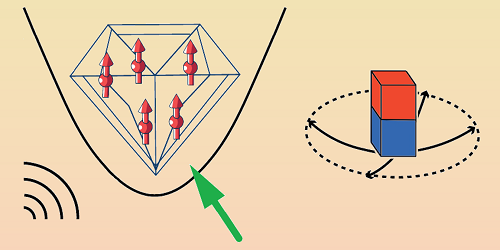Spin Control in a Levitating Diamond
Cooling a small floating object to near absolute zero could reveal quantum behavior at a macroscopic level. One way to achieve this cooldown is by coupling the object’s motion to its magnetic spins. In this approach, repeatedly aligning the spins causes them to absorb more and more energy from the motion, gradually reducing the motion. Throughout this process, the spins must be coherent—that is, in a well-defined quantum state—and the challenge has been to attain a sufficiently long coherence time. Now Gabriel Hétet and his colleagues at the École Normale Supérieure, France, have applied nuclear magnetic resonance (NMR) techniques to a microscopic levitating diamond [1]. The researchers achieved a spin coherence time that was more than 1000 times longer than previous records for levitating objects.
Hétet and his colleagues used a microdiamond containing thousands of so-called nitrogen-vacancy centers, defects in which two neighboring carbon atoms in a diamond’s crystal lattice are replaced with a nitrogen atom and a lattice vacancy. The researchers levitated this microdiamond in an electric field and aligned the electronic spins of the nitrogen-vacancy centers using green laser light. They then used NMR techniques (applying magnetic fields and radio waves) to manipulate and detect the nuclear spins of the nitrogen atoms in these centers. The manipulation brought the nuclear spins into alignment with the optically aligned electronic spins.
The team measured a coherence time for the nuclear spins of up to hundreds of microseconds. This duration could be long enough for the microdiamond’s motion to be greatly reduced through many cycles of nuclear-spin alignment. The researchers suggest that this coherence time could be further extended using higher-quality microdiamonds than those used in their work.
Correction (27 November 2024): The article was corrected to clarify that the microdiamond’s motion is reduced rather than the object itself being cooled.
–Ryan Wilkinson
Ryan Wilkinson is a Corresponding Editor for Physics Magazine based in Durham, UK.
References
- J. Voisin et al., “Nuclear magnetic resonance with a levitating microparticle,” Phys. Rev. Lett. 133, 213602 (2024).




